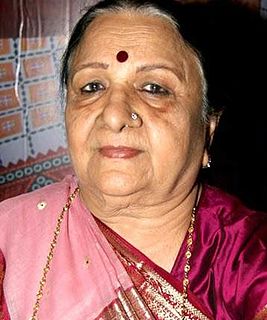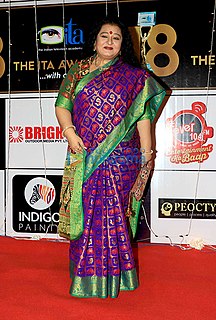
Kyunki Saas Bhi Kabhi Bahu Thi is an Indian soap opera that aired from 3 July 2000 to 6 November 2008 on Star Plus. The entire series is available on Hotstar. The show was co-produced by Shobha Kapoor and Ekta Kapoor under their banner Balaji Telefilms.

Kahaani Ghar Ghar Kii is a Hindi-language Indian soap opera on Indian television which ran on Star Plus from 16 October 2000 to 9 October 2008. The soap opera was created by Ekta Kapoor and was produced by her production company Balaji Telefilms which starred Sakshi Tanwar

Kasautii Zindagii Kay is an Indian television series created by Ekta Kapoor's Balaji Telefilms on Star Plus. The show starred Shweta Tiwari, Cezzane Khan later replaced by Hiten Tejwani, Ronit Roy and Urvashi Dholakia who portrayed Prerna Sharma, Anurag Basu, Rishabh Bajaj and Komolika Majumdar. The show explored the story of the star crossed lovers Anurag and Prerna. The various stages of their love and life as well as the lives of their children, grandchildren and at the end, great-grandchildren.

Himani Bhatt Shivpuri is an Indian actress known for her character roles in Bollywood films and Hindi soap operas. Her films include Hum Aapke Hain Koun..! (1994), Raja (1995), Dilwale Dulhania Le Jayenge (1995), Khamoshi (1996), Hero No. 1 (1997), Deewana Mastana (1997), Bandhan (1998), Kuch Kuch Hota Hai (1998), Biwi No.1 (1999), Hum Saath-Saath Hain (1999), Kabhi Khushi Kabhie Gham... (2001) and Main Prem Ki Diwani Hoon (2003).

Hiten Tejwani is an Indian television actor. He is known for his work in several fictional popular soaps and participation in the reality series Bigg Boss 11.

Sudha Shivpuri was an Indian actress who was most famous for her role as Baa in the Hindi TV serial Kyunki Saas Bhi Kabhi Bahu Thi (2000–2008).

Shilpa Saklani is an Indian actress. She is known for her role as Ganga Sahil Virani in Kyunki Saas Bhi Kabhi Bahu Thi and Vidhi in Jassi Jaissi Koi Nahin. She was a contestant on the reality show Bigg Boss 7. She was also seen as Queen Ratnaprabha in Chandrakanta and Roma Kapoor in Kaleerein. She was last seen as Vrinda in Vish Ya Amrit: Sitara.

Jaya Bhattacharya is an Indian television actress. She is known for playing antagonistic roles in TV serials. She has also done small roles in movies. Best known for playing Payal in soap opera Kyunki Saas Bhi Kabhi Bahu Thi, she also played the roles of Jigyasa Bali in Kasamh Se, Sakku Bai in Jhansi Ki Rani, and Sudha Buaa in Gangaa. She again gained popularity with her role of Vasundhara Pandey in drama series Thapki Pyar Ki (2015–2017). She appeared on Silsila Badalte Rishton Ka (2018–2019).

Rakshanda Khan is an Indian model, television actress and anchor recognized for her portrayal of Mallika Seth in Jassi Jaissi Koi Nahin, Tanya Malhotra in Kyunki Saas Bhi Kabhi Bahu Thi, Roshni Chopra in Kasamh Se and Naagin Sumitra in Naagin 3.

Akashdeep Saigal is an Indian television actor known for his portrayal of Ansh Virani and Eklavya Virani in Kyunki Saas Bhi Kabhi Bahu Thi as well as participating in Bigg Boss 5.

Achint Kaur is an Indian television and Cinema actresses and is best known for playing the antagonists Mandira and Pallavi in Ekta Kapoor's Indian soap operas Kyunki Saas Bhi Kabhi Bahu Thi and Kahaani Ghar Ghar Kii, respectively, on Star Plus. She is also the voice behind Shenzi character played in the movie The Lion King. She was also seen playing a mother and a mother-in-law in the serial Jamai Raja.

Apara Jariwala is an Indian television and Bollywood actress known for her supporting roles like Savita Mansukh Virani in the iconic show Kyunki Saas Bhi Kabhi Bahu Thi.

Amar Upadhyay is an Indian television actor and model known for his roles of Mihir Virani and Dharam Suryavanshi in the long-running soap operas Kyunki Saas Bhi Kabhi Bahu Thi and Saath Nibhaana Saathiya respectively, both of which aired on Star Plus. He was a contestant on the reality show Bigg Boss 5 in 2011.

Aman Verma is an Indian television anchor and actor. As an anchor, Verma is best known for hosting the game show Khullja Sim Sim on Star Plus from 2001 to 2004. His other hosting duties were with Mini Mathur in the first season of Indian Idol on Sony TV and Zee TV's Zee Cinestars. He has also acted in Bollywood movies. Verma was also seen in Life OK's show Hum Ne Li Hai- Shapath as ACP Diler Kumar. He also participated in the ninth season of Indian reality series Bigg Boss.

Nivedita Basu is an Indian television producer who worked as Creative Director at Balaji Telefilms. Nivedita turned producer in 2015 and owns a celebrity cricket team on the television reality show Box Cricket League.

Rucha Gujarathi is an Indian Bollywood, television actress and model. She has acted in several Bollywood movies, soap operas, music albums and reality shows. She also acted as a child artist in several movies. She is best remembered for her lead role as "Suhana" in Hindi language soap opera Bhabhi on Star Plus.
Kamalika Guha Thakurta is an Indian television actress who hails from West Bengal. She made her debut with Mujhe Chaand Chahiye and found success with Kyunki Saas Bhi Kabhi Bahu Thi.
The Star India v Leo Burnett case was heard before the Bombay High Court in 2003. The case revolved around using the TV show Kyunki Saas Bhi Kabhi Bahu Thi as a basis for a Tide detergent commercial and whether this violated copyright law.
Jiten Lalwani is an Indian film and television actor. He is best known for playing Kiran Virani on Kyunki Saas Bhi Kabhi Bahu Thi, Inder Kashyap in Sasural Genda Phool and Samarjeet in Naagin 3.

Char Divas Sasuche is an Indian Marathi soap opera that aired on ETV Marathi. It is the second longest running Indian serial with over 3,147 episodes. It was premiered on November 2001 and ended on 5 January 2013. It was directed by Khalil Herekar

















